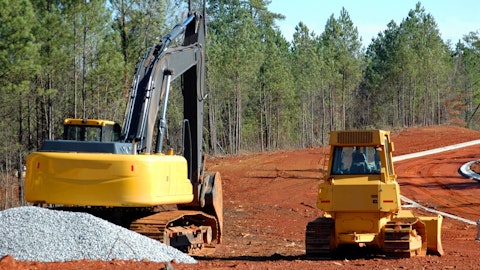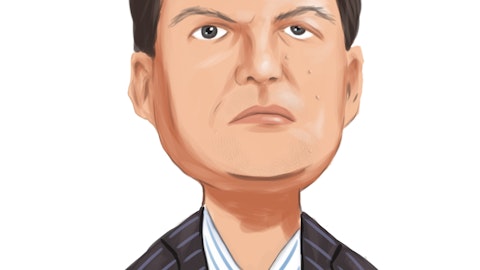Art Suazo: And Alex, if you — we’re 40% inactive process right now, which we feel really good about. But you made a comment about small tenants. Yeah, that’s exactly right. That number is going to grow, because our average tenant size is well under 10,000 square feet. The later year and these tenants aren’t engaging just yet. So this doesn’t reflect that, once they start engaging, the small tenants are going to — that number in the aggregate is going to help us a great deal.
Alexander Goldfarb: Thank you.
Operator: The next question comes from Michael Griffin with Citi. Please go ahead. Hello, Michael. Your line is now open. Please proceed with your question.
Michael Griffin: Sorry, sorry, I was on mute there. Question for Harout. Just kind of on the cash balance and sources and uses. If we look, I guess, relative to last quarter from this quarter, your cash balance went up about $25 million. But then I’m just trying to reconcile the $700 million that came in from the One Westside proceeds and then paying off the construction loans there gets me to about $500 million or so. Maybe you have net cash proceeds. So could you walk me through kind of where the remainder of that went and any commentary around that would be helpful?
Harout Diramerian: Sure. Just a reminder, the $700 million is not all ours. We have a 25% partner. And so we take the $700 million. There are some closing costs. There is a hold back of about $16 million that’s — that we should get by the end of 2024 and the remainder was first used to pay down the construction loan and then our net proceeds were used to pay down our line of credit. So, every dollar — every extra dollar we had, we used to pay down line of credit. So we have another — like I said, another $16 million coming to us. Well, split between us and Macerich. That will come at the end of 2024.
Michael Griffin: Gotcha. That’s helpful. And then maybe just the more broad question on your markets and distressed opportunities you’re seeing out there. Obviously, it seems like, one of the priorities is to pay down debt and get the balance sheet in better order. But if you do see distress out there, could you look to capitalize on any opportunities?
Harout Diramerian: Yeah. Michael, listen, we were not seeing distress that is attracting us right now. We are evaluating price per pound and the cap rate movements in all of our markets. But there’s not a tremendous amount of deals out there that are truly the forefront deals that, I guess, Hudson would want to partake in right now. We’ve got our finger on the pulse clearly as to what’s in the marketplace. I would say the activity that you’re seeing that has been, obviously, given back to some of the lenders or certain sellers are looking to sell assets. There’s more about it like an owner user type aspect versus a value add aspect right now. That being said, I think, we’re going to see some opportunities that may be intriguing with existing partners on assets that we may have opportunities of taking out at some pretty good valuations for the company to move forward on if there’s upside in those assets.
So we’re in the market, I would say, of course, everybody’s focused on San Francisco because of its depressed aspect, but there’s only been a few deals done there. There’s going to be opportunities in Seattle. There’s going to be opportunities in the Valley and there’s also going to be opportunities in Los Angeles.
Michael Griffin: Great. That’s it for me. Thanks for the time.
Operator: The next question comes from Blaine Heck with Wells Fargo. Please go ahead.
Blaine Heck: Great. Thanks. Good morning. I was hoping you guys could give a little bit more color. I know you guys are done breaking out studio versus office same-store guidance, but I do think that coming into 2024, there was some optimism that the studio side could show some better results in the services business that could offset some headwinds on the office side. So, any sort of general color you could give on the contribution of each of those to the overall same-store number would be really helpful?
Harout Diramerian: So, we made a decision a while ago to only provide same-store for the company overall instead of breaking it out between the two. But you can see that the preponderance of our business is the office side and that’s been the driver of our projection. There’s some growth, obviously, in the media side, but the driver for at least 2024 is office. But just as a reminder, the Quixote business, which is the operating business, is not in our same-store numbers. So if you add that in and we change the definition of same-store, I think, we’d be up 5% year-over-year. So just to give you some context there.
Blaine Heck: Okay. That’s helpful, Harout. Just a follow up on that to dig in on the office side. You do have a lot of vacancy at 1455 Market from the Block move out. Can you just give us an update on your thoughts around backfilling that space and what’s included in guidance, if anything?
Victor Coleman: Yeah. Let me start and I’m going to have Art dig in. We have right now in negotiations about 155,000 feet of deals. I think that could grow substantially with some existing negotiations and interest levels over the next 12 months to 24 months. The assets uniquely positioned because of the current build out with Block and Uber. That space is so unique and large floor plates plane that that seems to be where the interest level is. Clearly the deals that we did with Block and Uber were at a different timeline. The market has shifted back to not necessarily where those levels were, but at least closer to where they were than where the rents would have been when they exited. So we still have some a little bit of headroom there and I think we’re comfortable with some of the aspects on those deals that we’re looking at.



